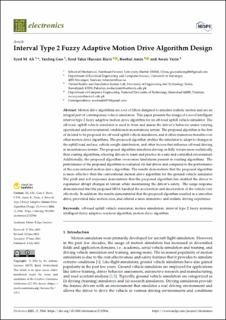| dc.contributor.author | Ali, Syed M. | |
| dc.contributor.author | Guo, Yanling | |
| dc.contributor.author | Rizvi, Syed Tahir Hussain | |
| dc.contributor.author | Amin, Roohul | |
| dc.contributor.author | Yasin, Awais | |
| dc.date.accessioned | 2023-09-19T08:49:53Z | |
| dc.date.available | 2023-09-19T08:49:53Z | |
| dc.date.created | 2023-09-15T16:39:40Z | |
| dc.date.issued | 2023-07 | |
| dc.identifier.citation | Ali, S. M., Guo, Y., Rizvi, S. T. H., Amin, R., & Yasin, A. (2023). Interval Type 2 Fuzzy Adaptive Motion Drive Algorithm Design. Electronics, 12(13), 2946. | en_US |
| dc.identifier.issn | 2079-9292 | |
| dc.identifier.uri | https://hdl.handle.net/11250/3090326 | |
| dc.description.abstract | Motion drive algorithms are a set of filters designed to simulate realistic motion and are an integral part of contemporary vehicle simulators. This paper presents the design of a novel intelligent interval type 2 fuzzy adaptive motion drive algorithm for an off-road uphill vehicle simulator. The off-road, uphill vehicle simulator is used to train and assess the driver’s behavior under varying operational and environmental conditions in mountainous terrain. The proposed algorithm is the first of its kind to be proposed for off-road uphill vehicle simulators, and it offers numerous benefits over other motion drive algorithms. The proposed algorithm enables the simulator to adapt to changes in the uphill road surface, vehicle weight distribution, and other factors that influence off-road driving in mountainous terrain. The proposed algorithm simulates driving on hilly terrain more realistically than existing algorithms, allowing drivers to learn and practice in a safe and controlled environment. Additionally, the proposed algorithm overcomes limitations present in existing algorithms. The performance of the proposed algorithm is evaluated via test drives and compared to the performance of the conventional motion drive algorithm. The results demonstrate that the proposed algorithm is more effective than the conventional motion drive algorithm for the ground vehicle simulator. The pitch and roll responses demonstrate that the proposed algorithm has enabled the driver to experience abrupt changes in terrain while maintaining the driver’s safety. The surge response demonstrated that the proposed MDA handled the acceleration and deceleration of the vehicle very effectively. In addition, the results demonstrated that the proposed algorithm resulted in a smoother drive, prevented false motion cues, and offered a more immersive and realistic driving experience. | en_US |
| dc.language.iso | eng | en_US |
| dc.publisher | MDPI | en_US |
| dc.rights | Navngivelse 4.0 Internasjonal | * |
| dc.rights.uri | http://creativecommons.org/licenses/by/4.0/deed.no | * |
| dc.title | Interval Type 2 Fuzzy Adaptive Motion Drive Algorithm Design | en_US |
| dc.type | Peer reviewed | en_US |
| dc.type | Journal article | en_US |
| dc.description.version | publishedVersion | en_US |
| dc.rights.holder | © 2023 by the authors | en_US |
| dc.subject.nsi | VDP::Teknologi: 500::Elektrotekniske fag: 540 | en_US |
| dc.source.pagenumber | 0 | en_US |
| dc.source.volume | 12 | en_US |
| dc.source.journal | Electronics | en_US |
| dc.source.issue | 13 | en_US |
| dc.identifier.doi | 10.3390/electronics12132946 | |
| dc.identifier.cristin | 2175606 | |
| dc.source.articlenumber | 2946 | en_US |
| cristin.ispublished | true | |
| cristin.fulltext | original | |
| cristin.qualitycode | 1 | |

